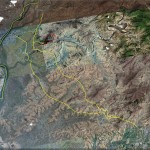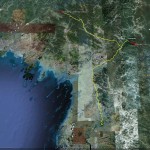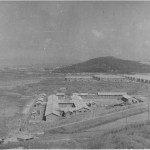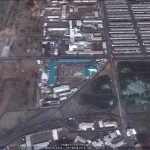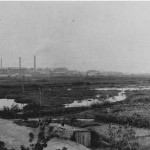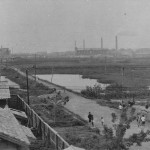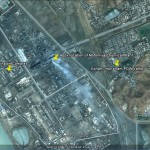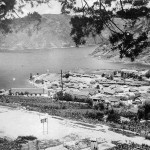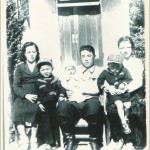UPDATE 6: Without a hint of irony the DPRK condemns South Korean efforts to block the Uriminzokkiri Twitter and YouTube pages. According to Evan Ramstad in the Wall Street Journal:
North Korea doesn’t let its citizens have computers or access to the Internet. But that hasn’t stopped it from complaining about South Korea’s attempts to block North Korean propaganda videos on YouTube and messages on Facebook and Twitter.
Uriminzokkiri, a North Korea-affiliated Web site run from a bank in Shenyang, China, has garnered worldwide headlines over the past month as it began using prominent social networking tools to draw more attention to its content, which routinely praises the North’s authoritarian regime and lambastes the U.S., South Korea and Japan.
South Korea’s government, which for decades has controlled mail, phone and other communication with the North, extended its oversight to Uriminzokkiri’s new accounts on YouTube, Facebook and Twitter. That prompted the website to post a notice on Saturday criticizing Seoul for censorship, without mentioning that Pyongyang engages in much more far-reaching censorship.
“It is clear that the Lee Myung-bak administration is a group of traitors against unification, and does not want to improve inter-Korean relations or even wish for dialogue and cooperation,” Uriminzokkiri said, citing the name of South Korean President Lee Myung-bak.
Since nearly all of the content on the Web site is in the Korean language, officials in South Korea believe it is mainly targeted at South Koreans.
The Korea Communications Commission, which governs telecommunications in South Korea, says the Uriminzokkiri Web site has “content that praises, promotes and glorifies” the North and has “illegal information” as defined by the South’s National Security Law.
And according to the AFP:
Pyongyang opened a Twitter account on August 12 after its foray into popular video-sharing website YouTube, prompting a game of online cat-and-mouse with Seoul which has struggled to stop its citizens following The North’s official website, Uriminzokkiri.
South Korea has been “crazy to stop its people from gaining access to video and messages posted on our YouTube and Twitter,” said a statement seen on the North’s website.
“This proves the group of traitors is an anti-unification faction, which does not want (inter-Korean) dialogue and cooperation,” it said, adding the South’s “dirty” move will only aggravate confrontation on the peninsula.
The North has used its Twitter account, opened under the name @uriminzok, to link to stinging statements against Seoul and the US posted on its official website.
Seoul has warned South Korean web users they face punishment for seeking to reply to or retweet North Korean messages, but Pyongyang has quickly gathered more than 10,000 followers.
North Korea, one of the world’s most controlled states, is believed to have an elite unit of hackers, but few of its citizens have access to a computer, let alone the Internet.
The North also launched its Facebook page on August 19 to post video links, wallpostings and pictures of happy picnickers, grassy parks and colourful landmarks from across Pyongyang.
Facebook is more expansive than Twitter as it allows users to upload a wide variety of multimedia contents. But the North’s Facebook disappeared only four days after its launch.
UPDATE 5: North Korea has issued a statement that it is not directly managing the Twitter and Youtube accounts. No one in the media seems to have heard of Chongryun or read my blog posts…
UPDATE 4: According to Yonhap, the DPRK has now opened a Facebook page. The profile apparently listed the manager of the site as a male interested in men. Eventually the site was shut down by Facebook, but was reopened under a different account name—and again closed. A parody site has opened and as of 8/23 it is still up with thousands of “likes”.
UPDATE 3: DPRK organization changing IP addresses to get around South Korean censors. According to Yonhap (8/19/2010):
North Korea is altering the online addresses of its statements denouncing South Korea and the United States in a new attempt to thwart Seoul’s bids to block access to them, an official said Thursday.
…
South Korea quickly blocked access by its nationals to the [Twitter account] , citing a law that requires them to gain government approval if they want to view such material.
An official at the Korea Communications Commission, however, said that North Korea continues to modify the Internet protocol (IP) addresses of its statements to fool the South Korean watchdog.
“We’re currently blocking new IP addresses as soon as we find them,” the official said, declining to be identified because he had yet to be allowed formally to give the information.
North Korea is currently running the Twitter account at https://twitter.com/uriminzok, which had nearly 8,700 subscribers, or “followers,” as of Thursday afternoon. It contained 20 messages, or “tweets,” most of them showing links to official statements uploaded on its Web site.
Some South Koreans said Wednesday and Thursday that they were able to read the North Korean statements via the links, sometimes even for hours, before they were blocked.
A warning that the uriminzokkiri site contains illegal material pops up if it is directly opened from South Korea. In 2004, the North tried changing the name of the site to “Wooriminzokkiri” to parry South Korean attempts to block access, the official said.
“It’s now the IP addresses that the North is altering,” he said. The Web addresses are only “domains” that make it easy for users to access the IP addresses where the statements are actually stored, he said.
North Korea appears to be expanding its propaganda warfare as South Korea and the United States step up their pressure on Pyongyang to admit to its wrongdoing and open up for dialogue.
Last month, Pyongyang opened an account with the global video-sharing site YouTube and started uploading clips that ridicule senior officials in Seoul and Washington.
…
The North Korean Twitter Web page “is more amusing than anything else,” Michael Breen, author of “The Koreans” who runs a communications consulting firm in Seoul, said. “The government here needs to lighten up and give its own people access and stop being afraid of the North Korean propaganda.”
“Twitter is a symbol of information technology. The South should consider ways to open the North through channels like Twitter rather than block them,” Yang Moo-jin, a professor at the University of North Korean Studies, said.
South and North Korea remain technically at war after the 1950-53 Korean War ended in a truce rather than a peace treaty. Their relations are at one of the worst points in history following the deadly sinking of a South Korean warship in March blamed on Pyongyang. The North denies involvement.
UPDATE 2: Whereas the US welcomes the DPRK to the Internet, South Korea bans the DPRK’s twitter account. Really. Lame. According to the Korea Herald (8/19/2010):
The government has asked domestic Internet service providers to block citizens access to a North Korean Twitter account because it breaches the national security laws.
The decision was made Thursday by the Communications Standards Commission to stem the rapid increase of subscriptions by South Korean nationals.
A page that warns of illegal material popped up when an attempt to access http://twitter.com/uriminzok was made. A similar page shows up if one tries to enter Web pages showing North Korea‘s propaganda material.
The block is seen as a confirmation that Seoul considers the North Korean Twitter page as being related to Pyongyang. A call asking for comment from an Internet watchdog official was not immediately returned. Seoul has been reluctant to conclude that North Korea is behind the account that opened last week.
At least 8,700 subscribers were “following” the North Korean Twitter account when the page was last accessed earlier Thursday.
South Korea allows its nationals to view online propaganda material posted by North Korea if they gain government clearance.
South Korean authorities had been blocking Web pages that could be accessed through links posted on the North’s Twitter account.
Earlier in the day, an official at the Korea Communications Commission, a watchdog, said North Korea was altering the online addresses of the pages to bypass Seoul’s block.
North Korea appears to be expanding its propaganda warfare as South Korea and the United States step up their pressure on Pyongyang to admit to its wrongdoing and open up for dialogue.
Last month, Pyongyang opened an account with the global video-sharing site YouTube and started uploading clips that ridicule senior officials in Seoul and Washington.
On Wednesday, South Korea warned its citizens that it may be considered illegal to interact with the North Korean Twitter account, apparently calling on them to refrain from reposting, or “retweeting,” the messages.
UPDATE 1: The US State Department welcomes the DPRK to Twitter and Youtube. According to Martyn Williams at PC World:
The U.S. government has welcomed North Korea’s jump onto Twitter and challenged the country to let its citizens see the recently created account.
“We use Twitter to connect, to inform, and to debate. We welcome North Korea to Twitter and the networked world,” wrote Philip Crowley, a state department spokesman on his Twitter account.
The message came days after Uriminzokkiri, the closest thing the insular country has to an official Web site, established a Twitter account. The account has to date posted messages only in Korean but that hasn’t stopped it becoming somewhat of a Twitter hit. Publicity from the launch has resulted in over 5,000 followers subscribing to the slow stream of government propaganda.
“The North Korean government has joined Twitter, but is it prepared to allow its citizens to be connected as well?,” asked Crowley on his Twitter account.
North Korea is one of the world’s most tightly controlled societies and Internet access is restricted to all but the most trusted members of government. Some people have access to a nationwide intranet, a closed network based on Internet technology that offers domestic Web sites and e-mail with no links to the outside world.
In recent years the country has taken steps to introduce modern communications technologies, but has typically done so cautiously. Residents of Pyongyang and several other cities can now subscribe to a mobile phone network, but direct dialling to overseas numbers isn’t available and calls between citizens and foreign residents are also restricted.
“The Hermit Kingdom will not change overnight, but technology once introduced can’t be shut down. Just ask Iran,” said Crowley in the final of three Twitter messages on the subject.
It’s likely that the experience of countries like Iran is causing North Korea to be cautious in the freedoms it allows citizens with technology. The Internet and mobile phones reportedly played an important part in the organization of anti-government rallies in Iran in 2009.
For its part, South Korea is signaling that it will not tolerate South Koreans utilizing DPRK internet options or pormoting DPRK internet content. Again, according to Martyn Williams in PC world:
Crowley’s comments come in the same week a court in South Korea, the North’s democratic southern neighbor, sentenced a man for posting material online that was sympathetic to North Korea.
The man, who was only identified in news reports as Lee, received a two-year prison sentence, suspended for three years, on Monday for posting pro-North Korean material on a blog, reported South Korea’s Yonhap news agency.
Lee fell foul of the country’s National Security Law, which prohibits the distribution of materials that praise the North, by posting links to other sites that hosted the material, said The Korea Times.
South Korea is also sending warnings over the DPRK’s twitter/Youtube accounts. According to Bloomberg:
South Koreans who post comments on a purported North Korean Twitter Inc. account may fall foul of national security laws that bar the country’s citizens from communicating with their Cold War foes.
“People would have to bear in mind that they could be violating the law” if it is confirmed to be North Korean, Unification Ministry spokeswoman Lee Jong Joo told reporters today in Seoul. The government is investigating the suspected accounts on Twitter and Google Inc.’s YouTube site, she said, without elaborating.
The warning underscores the government’s wariness about exposing its citizens to North Korean propaganda, even after the past two decades have delivered democracy and developed-world living standards in the South as the North became mired in aid- dependency and chronic shortages of food and goods. South Koreans are unable to access North Korean-linked websites, or call telephone numbers across the border.
“It’s almost inconceivable that South Koreans will actually buy into North Korea’s propaganda and start following their ideology,” said Kim Yong Hyun, a professor of North Korean studies at Dongguk University in Seoul. “Still, the government will feel the need to approach this issue in a conservative manner, given the existing laws.”
Under the law governing exchanges with North Korea, South Koreans need to notify the government when they come in contact with North Koreans and seek prior approval when traveling across the border. Another law on national security bans supporting “anti-state” groups, often interpreted to mean the regime of North Korean leader Kim Jong Il.
ORIGIANL POST: Following last week’s announcement that the folks at Uriminzikkiri had opened a YouTube account, the same group has now apparently set up a Twitter account.
According to Yonhap:
Less than one month after the communist state started broadcasting propaganda clips on the global video-sharing site YouTube, North Korea opened an account on Thursday with Twitter Inc., the U.S. provider of a highly popular microblogging service.
The opening, announced Saturday on North Korea’s official Web site Uriminzokkiri, comes as Pyongyang steps up its propaganda offensive to deny allegations that its Navy torpedoed a South Korean warship in March, killing 46 sailors.
The North’s twitter account, which opened under the name uriminzok, or “our nation” in Korean, contained nine messages as of Sunday morning. Most of them had links to statements or interviews that denounce South Korea and the United States.
Twitter allows users to send texts up to 140 characters long, known as “tweets.” Subscribers, or “followers,” can choose to receive feeds via mobile phones or personal computers. Eight people were following uriminzok as of Sunday morning.
The KFA still insists that it hosts the official DPRK webpage–but they are not doing as good a job as these North Koreans at keeping up with the capabilities of the Internet.
Read the full story here:
N. Korea joins twitter fever to step up propaganda offensive
Yonhap
Sam Kim
8/15/2010

